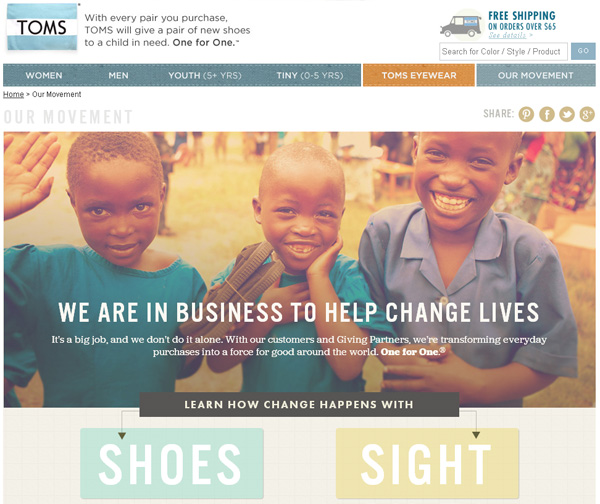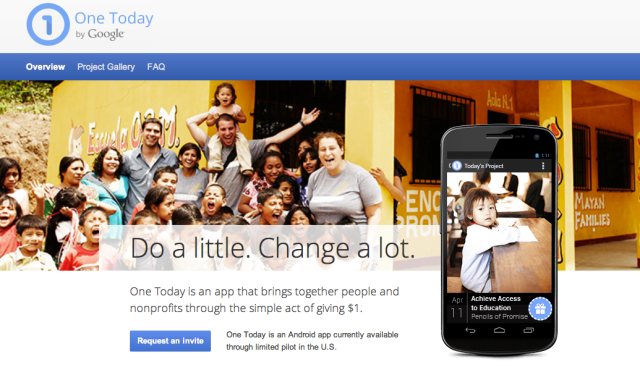Today, brands’ acts of philanthropy obviously go beyond writing checks to various institutions. Online and offline large-scale projects by global companies often move out of the brands’ universe, evolving into initiatives that live somewhat independently from their founders. Why do brands spend time and money on things that don’t generate direct revenue? Is mere kudos really worth putting great recourses into socially related non-profit initiatives? What approaches and channels do brands use to fuel philanthropy causes and what drives such activity? This article overviews some examples of how businesses help tackle the urgent social problems through philanthropy.
“A company’s philanthropy tells you what it is at its core. So companies have to think seriously about how to use their marketing dollars to do things out in the world that make a difference to the people who are part of their brands,” told Shelly Lazarus, chairman of Ogilvy & Mather Worldwide, to Forbes back in 2010.
Philanthropy comes as an important element of businesses’ sustainability strategy. Most often brands show they are socially conscious in times of natiral disasters and tragedies that affect thousands or even millions of people. Still, long-standing problems such as shortage of water, food, clothes and other essentials in poor areas, diseases, non-sustainable practices and more are also subjects of the brands’ initiatives. Companies use three major channels to contribute to a better world through philanthropy—by giving or helping raise funds; launching online databases and large-scale initiatives; and organizing long-term projects to engage people in developing a wholly new social, medical, urban, etc. environment.
Fundraising and Giving
To help alleviate post-effects of tragedies and contribute to tackling long-standing problems, global brands usually give big amounts of money to charitable organizations. Still, for better impact and social integration simple donating practice should include consumer engagement as well.
While giving seems to be one of the most common ways of support in times of need, social-media landscape has added new elements to this common practice. All forms of digital affections, from liking to sharing, help brands spread awareness about some particular causes. For instance, a kind of egocentric “pin to win” scheme on Pinterest has evolved into the charitable “pin to give” movement, adopted by a range of labels including Sony, Diane von Furstenberg, Elizabeth Arden. They encouraged users to share imagery to help people in need.
Pic.: TOMS’s One for One initiative
Matching brand’s donations to purchases or people’s contributions is a wide-spread approach. In late 2011, Coca-Cola launched its large-scale multi-platform polar bear-themed campaign calling consumers to buy cans with special designs and enter codes from the packaging to generate more donations to WWF’s initiative aiming to save the kings of the Polar areas. Coke coupled $1.8 in direct contribution from consumers with the company’s $2 million commitment.
As part of its ongoing One for One commitment, TOMS gives one new pair of shoes to poor kids for every TOMS pair purchased, and helps give sight for a person in need for every brand’s pair of glasses that was bought. Back in 2009, General Mills launched its “Join My Village” initiative aiming to generate money to provide economic and educational opportunities to young women and girls in Malawi and India. The project is still functioning—so far, it has generated over $3 million, people’s donations are matched dollar-for-dollar by General Mills and Merck.
Pic.: Google’s One Today project
Some brands set a fixed sum of donation, some ask consumers to choose for themselves. Still, there hardly can be a smaller sum than suggested by Google as part of its pilot U.S. initiative, One Today. The company is inviting Americans to donate $1 to different good causes via the Android-based app—before putting their nickels in the alms box, users can see how these micro donations can contribute to tackling problems around the globe.
Open Online Databases and Platforms
Digital era has changed the way people communicate, and this becomes obvious in the most challenging conditions. The recent terroristic attack in Boston showed how powerful and engaging social-media channels might be. For instance, Reddit launched the findbostonbombers hub as a discussion forum, which was a nice idea in general, but turned into somewhat like an example of old vigilantism as some people saw it. The Boston Police Department used their official Twitter to share information and also collect potential evidence, and the news there appeared faster than on TV. So, social-media platforms are becoming the perfect settings for developing socially focused initiatives without donating any money.
Responding to the tragic event, Google updated its Person Finder platform, part of its Google Crisis Response platform, to help search for people in Boston after the explosions. The site featured lists records for over 4,500 people, allowing users to search for people to see if they were safe as well as submit info on where their current location was. Google has been initiating, funding and supporting a vast majority of social programs for years. In 2011, the brand in cooperation with Red Cross launched crisis preparedness website to help people organize their efforts during natural disasters. The humanitarian organization also collaborated with Dell to launch the Digital Operations Center in 2012 and released an application for iOS and Android devices, providing expert advice on everyday emergencies.
The latest Google’s collaborative humanitarian project on the list is Human Trafficking Hotline Network, created to address modern slavery, builds on the principles of uniting technology and data from several bases to build a large-scale global initiative, that follows a last year’s platform for sharing stories of former extremists and victims of violent conflicts. MTV’s arm, mtvU, launched a dedicated hub Against Our Will Campaign in 2011 to expand the modern anti-slavery movement among American college students and get more people involved.
In 2012, Facebook suggested its users in 19 countries (the USA, the UK, Australia, Japan, Mexico and more) to share their organ donor status on their pages. People, signed as donors at the appropriate registry, were invited to add this information to their timeline as a life event.
Long-Term Curated Initiatives to Improve Social Landscape
While all the previous efforts can’t be overestimated, establishing multi-year initiatives to reshape attitudes, routines and lifestyles on the national and global level seems to be yet more important.
Back in 2011, BMW launched an unprecedented project—the BMW Guggenheim Lab. It was conceived as a mobile laboratory designed to inspire research and start thought-provoking conversations about enhancing urban life through architecture, smart transport system and more. The 6-year lab has already made three stops—in New York (summer-fall 2011), Berlin (summer 2012) and Mumbai (winter 2012- 2013). In the first two years, the project has been exploring the Confronting Comfort theme, and this first part of the odyssey will conclude with an exhibition at the Solomon R. Guggenheim Museum later in 2013. The website of the project invites the global audience to submit their ideas on how to improve comfort in urban areas (up to 70 characters). There, users can play the Urbanology Online game to visualize their future city by answering 10 key questions. They can also rate the level of comfort in various city settings and compare the results with their counterparts.
Pic.: BMW Lab’s Urbanology game
IBM also focuses on the urban improvement theme, but unlike BMW it’s not engaging public into its activities. The multi-year IBM Smarter Cities Initiative is more about putting the innovative urban-related ideas into life in various areas, rather than reaching audience for discussing the problems. The company enables users to measure the progress of their urban areas by using the smarter city assessment tool (PDF guides) and provides insights into successfully implemented practices.
Another way of paving the road to positive change is supporting creative visionaries through multi-year initiatives. For example, Google and Facebook co-founders in cooperation with other tech billionaires have recently introduced the Breakthrough Prize in Sciences Foundation to recognize innovators in the science field —in its inaugural year, each of the selected 11 scientists were awarded with a $3m prize.
Pic.: The logo of the Breakthrough Prize in Life Sciences
Some ideas to consider for planning a goodwill marketing strategy:
1. Give a nickel, get a dollar. Providing financial support for some social projects is one the best PR tools—philanthropy makes you a kind and socially positive brand.
2. Philanthropy is the marketing of tomorrow. In around ten years, socially-conscious initiatives launched by businesses, not governments, may become more powerful.
3. Contribute to the future. Serving short-term goals is great, but powerful brands should also consider sharing profits and expertise for facilitating global changes in major areas of life.
Those who don’t want to tie their acts of philanthropy and goodwill to any brands, can contribute to a good cause with the help of one of the online platforms: Donatetosavetheworld.org, Catchafire.org, Crowdrise.com, Globalgiving.org and Change.org.



